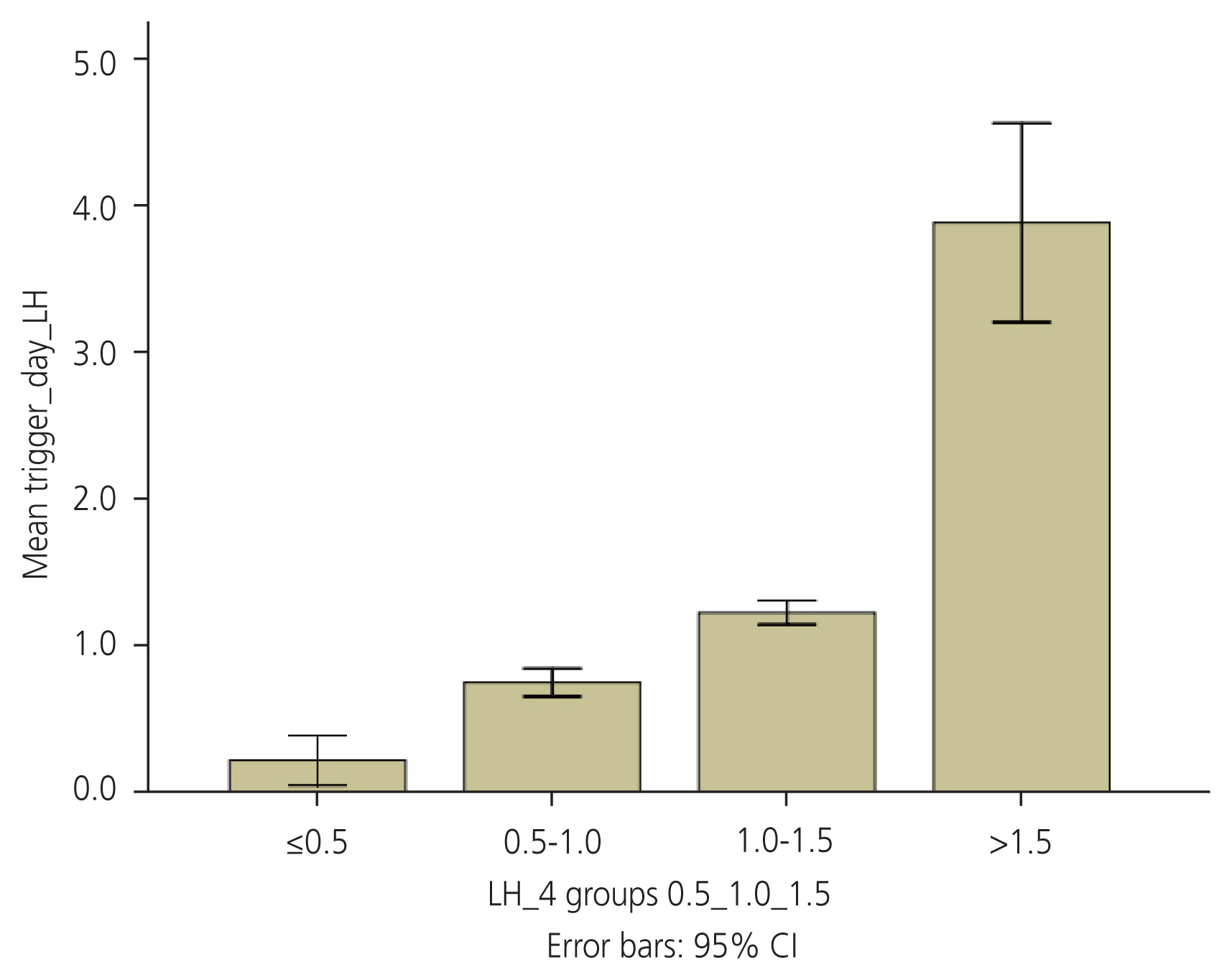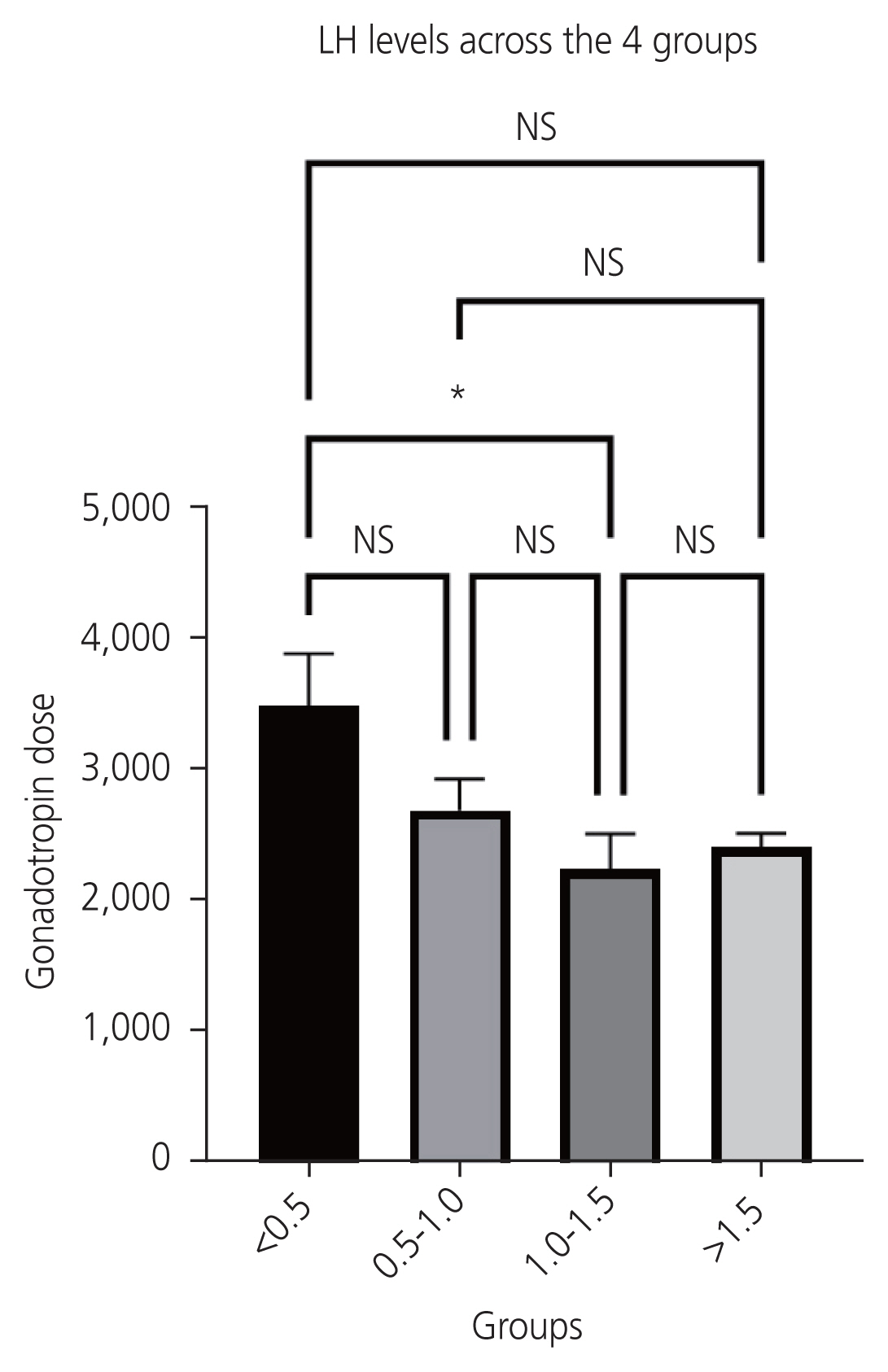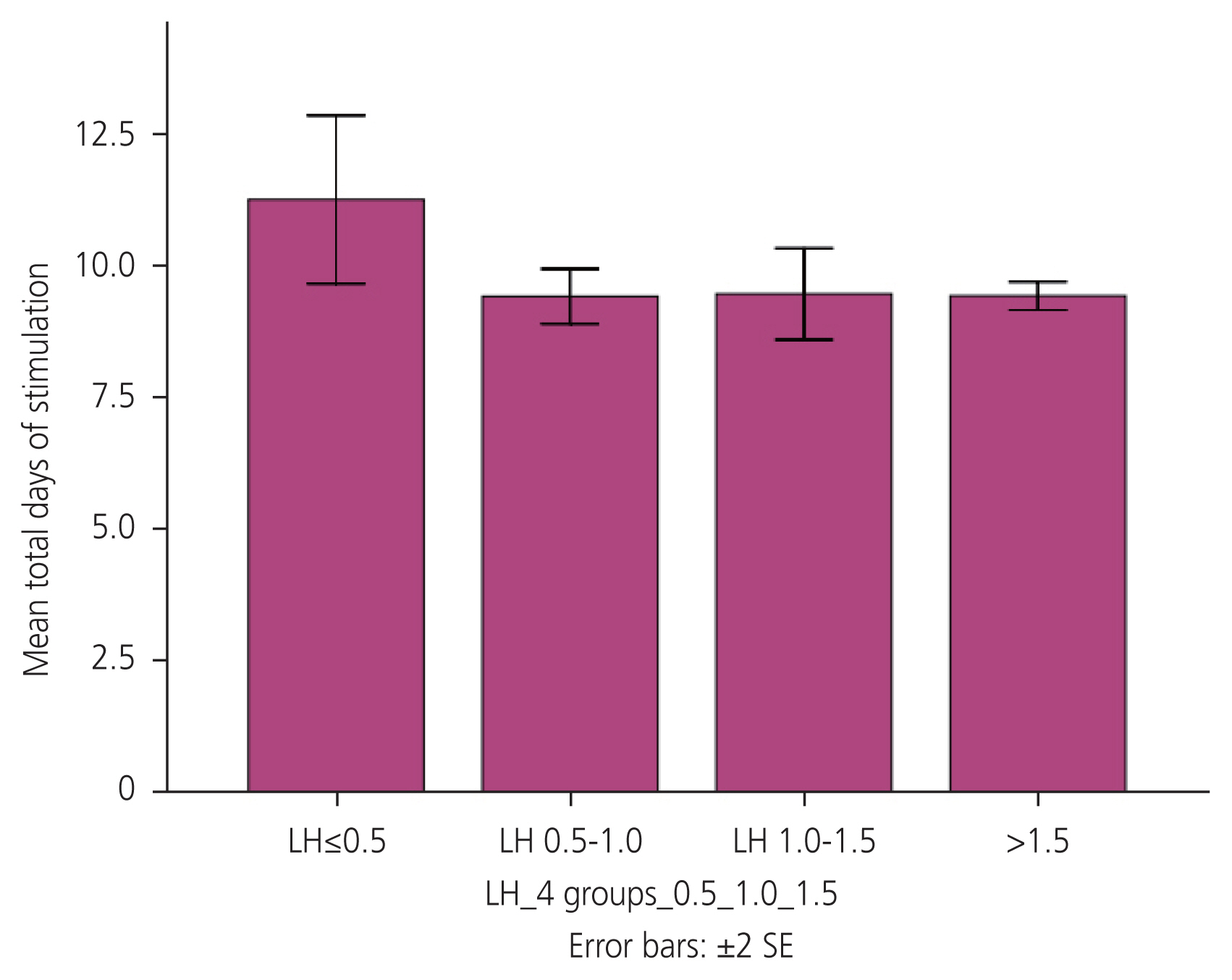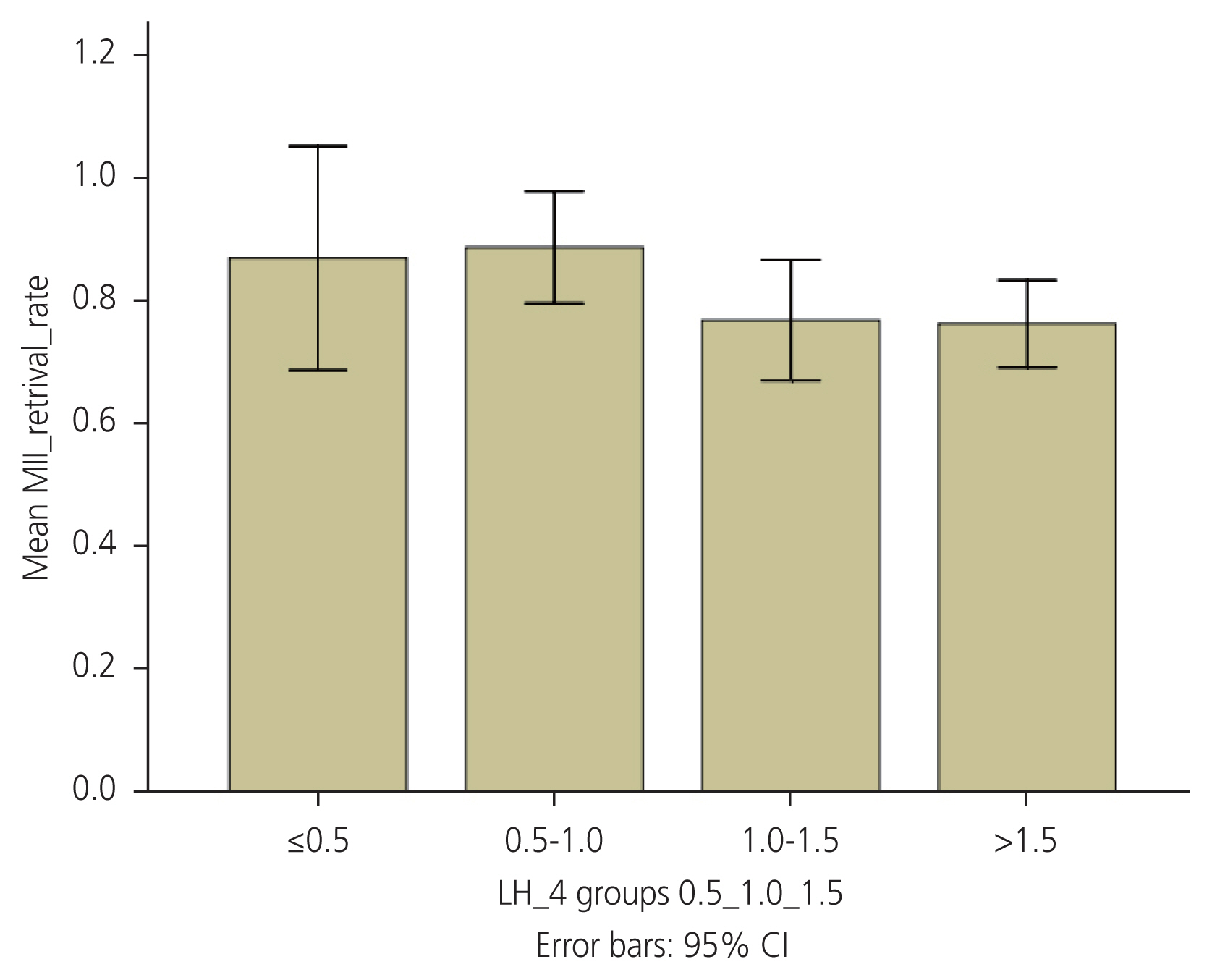Obstet Gynecol Sci.
2024 Mar;67(2):235-242. 10.5468/ogs.23215.
Effect of trigger day serum luteinising hormone levels on the in-vitro fertilization outcome: an observational study
- Affiliations
-
- 1Department of Obstetrics and Gynecology, All India Institute of Medical Sciences, Bilaspur, India
- 2Consultant Biochemistry and COO, India
- 3Consultant Reproductive Medicine, Milann Fertility Center, India
- 4Department of Reproductive Medicine, Medline Academics, Bangalore, India
- KMID: 2553431
- DOI: http://doi.org/10.5468/ogs.23215
Abstract
Objective
Controlled ovarian stimulation leads to profound changes in the endocrine characteristics of the ovarian cycle. Serum luteinising hormone (LH) levels on the day of trigger have been shown to correlate with oocyte quality and pregnancy rate in antagonist cycles.
Methods
This is an observational study of 86 women undergoing an antagonist in-vitro fertilisation cycle. Oocyte maturation trigger used was either Inj. human chorionic gonadotropin or Inj. triptorelin 0.2 mg s/c or a combination of both. Women were categorised into four groups based on serum LH levels on the day of trigger i.e., LH ≤0.5 (n=8), LH=0.6- 1.0 international units (IU)/L (n=12), LH=1.0-1.5 IU/L (n=13), and LH >1.6 IU/L (n=53) and the subgroup analysis was done based on type of trigger used.
Results
Mature oocyte (MII) retrieval rate did not show a significant relation with serum LH levels (87%, 89%, 77%, and 76% in groups with LH <0.5, 0.5-1.0, 1.0-1.5, and >1.5 IU/L respectively; P-value=0.243). There was no significant difference in the clinical pregnancy rate either when women were split according to the type of trigger given or according to trigger day LH levels. Women with low LH levels (<0.5 IU/L) required significantly more doses of gonadotropins compared to women with LH levels of 1.0-1.5 IU/L. (3,531+1,133 vs. 2,281+938; P-value=0.01).
Conclusion
Based on the observation from the current study, there was no significant association of serum LH levels with MII retrieval rate and clinical pregnancy rate. The group with low LH levels required slightly longer days of stimulation.
Figure
Reference
-
References
1. van der Gaast MH, Eijkemans MJC, Van der Net JB, Boer EJ, Burger CW, Van Leeuwen FE, et al. Optimum number of oocytes for a successful first IVF treatment cycle. Reprod Biomed Online. 2016; 13:476–80.2. Blockeel C, Sterrenburg MD, Broekmans FJ, Eijkemans MJ, Smitz J, Devroey P, et al. Follicular phase endocrine characteristics during ovarian stimulation and GnRH antagonist cotreatment for IVF: RCT comparing recFSH initiated on cycle day 2 or 5. J Clin Endocrinol Metab. 2011; 96:1122–8.3. Al-Inany H, Aboulghar M. GnRH antagonist in assisted reproduction: a cochrane review. Hum Reprod. 2002; 17:874–85.4. Halim B, Lubis HP. Dual trigger with gonadotropin-releasing hormone agonist and recombinant human chorionic gonadotropin improves the outcome of intrauterine insemination. Obstet Gynecol Sci. 2022; 65:207–14.5. Zhou R, Dong M, Huang L, Zhu X, Wei J, Zhang Q, et al. Association between serum LH levels on hCG trigger day and live birth rate after fresh embryo transfer with GnRH antagonist regimen in different populations. Front Endocrinol (Lausanne). 2023; 14:1191827.6. Benmachiche A, Benbouhedja S, Zoghmar A, Humaidan P. Low LH level on the day of GnRH agonist trigger is associated with reduced ongoing pregnancy and live birth rates and increased early miscarriage rates following IVF/ICSI Tteatment and fresh embryo transfer. Front Endocrinol. 2019; 10:639.7. Meyer L, Murphy LA, Gumer A, Reichman DE, Rosenwaks Z, Cholst IN. Risk factors for a suboptimal response to gonadotropin-releasing hormone agonist trigger during in vitro fertilization cycles. Fertil Steril. 2015; 104:637–42.8. Lu X, Hong Q, Sun L, Chen Q, Fu Y, Ai A, et al. Dual trigger for final oocyte maturation improves the oocyte retrieval rate of suboptimal responders to gonadotropin-releasing hormone agonist. Fertil Steril. 2016; 106:1356–62.9. Beckers NG, Macklon NS, Eijkemans MJ, Ludwig M, Felberbaum RE, Diedrich K, et al. Nonsupplemented luteal phase characteristics after the administration of recombinant human chorionic gonadotropin, recombinant luteinizing hormone, or gonadotropin-releasing hormone (GnRH) agonist to induce final oocyte maturation in in vitro fertilization patients after ovarian stimulation with recombinant follicle-stimulating hormone and GnRH antagonist cotreatment. J Clin Endocrinol Metab. 2003; 88:4186–92.10. Weston AM, Zelinski-Wooten MB, Hutchison JS, Stouffer RL, Wolf DP. Developmental potential of embryos produced by in-vitro fertilization from gonadotrophin-releasing hormone antagonist-treated macaques stimulated with recombinant human follicle stimulating hormone alone or in combination with luteinizing hormone. Hum Reprod. 1996; 11:608–13.11. Shoham Z, Balen A, Patel A, Jacobs HS. Results of ovulation induction using human menopausal gonadotropin or purified follicle-stimulating hormone in hypogonadotropic hypogonadism patients. Fertil Steril. 1991; 56:1048–53.12. Griesinger G, Dawson A, Schultze-Mosgau A, Finas D, Diedrich K, Felberbaum R. Assessment of luteinizing hormone level in the gonadotropin-releasing hormone antagonist protocol. Fertil Steril. 2006; 85:791–3.13. Westergaard LG, Laursen SB, Andersen CY. Increased risk of early pregnancy loss by profound suppression of luteinizing hormone during ovarian stimulation in normogonadotrophic women undergoing assisted reproduction. Hum Reprod. 2000; 15:1003–8.14. Propst AM, Hill MJ, Bates GW, Palumbo M, Van Horne AK, Retzloff MG. Low-dose human chorionic gonadotropin may improve in vitro fertilization cycle outcomes in patients with low luteinizing hormone levels after gonadotropin-releasing hormone antagonist administration. Fertil Steril. 2011; 96:898–904.15. Kummer N, Benadiva C, Feinn R, Mann J, Nulsen J, Engmann L. Factors that predict the probability of a successful clinical outcome after induction of oocyte maturation with a gonadotropin-releasing hormone agonist. Fertil Steril. 2011; 96:63–8.16. Merviel P, Antoine JM, Mathieu E, Millot F, Mandelbaum J, Uzan S. Luteinizing hormone concentrations after gonadotropin-releasing hormone antagonist administration do not influence pregnancy rates in in vitro fertilization-embryo transfer. Fertil Steril. 2004; 82:119–25.17. Chen SL, Ye DS, Chen X, Yang XH, Zheng HY, Tang Y, et al. Circulating luteinizing hormone level after triggering oocyte maturation with GnRH agonist may predict oocyte yield in flexible GnRH antagonist protocol. Hum Reprod. 2012; 27:1351–6.18. Lin YC, Chang SY, Lan KC, Huang HW, Chang CY, Tsai MY, et al. Human oocyte maturity in vivo determines the outcome of blastocyst development in vitro. J Assist Reprod Genet. 2003; 20:506–12.19. Veek LL. An Atlas of human gametes and conceptuses. 1st ed. London: Parthenon;1999.20. Orvieto R. Triggering final follicular maturation--hCG, GnRH-agonist or both, when and to whom? J Ovarian Res. 2015; 8:60.21. Kuang Y, Chen Q, Fu Y, Wang Y, Hong Q, Lyu Q, et al. Medroxyprogesterone acetate is an effective oral alternative for preventing premature luteinizing hormone surges in women undergoing controlled ovarian hyperstimulation for in vitro fertilization. Fertil Steril. 2015; 104:62–70e3.22. Zhu X, Zhang X, Fu Y. Utrogestan as an effective oral alternative for preventing premature luteinizing hormone surges in women undergoing controlled ovarian hyperstimulation for in vitro fertilization. Medicine (Baltimore). 2015; 94:e909.23. Luo X, Deng B, Li L, Ma R, Mai X, Wu Z. LH level on ovulation trigger day has a different impact on the outcomes of agonist and antagonist regimens during in vitro fertilization. J Ovarian Res. 2023; 16:26.
- Full Text Links
- Actions
-
Cited
- CITED
-
- Close
- Share
- Similar articles
-
- Serum Anti-Mullerian Hormone and Inhibin B Levels at Ovulation Triggering Day Can Predict the Number of Immature Oocytes Retrieved in In Vitro Fertilization Cycles
- The effective of ultrashort-term gonadotropin-releasing hormone agonist administration in controlled ovarian hyperstimulation for in vitro fertilization
- The use of gonadotropin-releasing hormone antagonist post-ovulation trigger in ovarian hyperstimulation syndrome
- Factors influencing serum progesterone level on triggering day in stimulated in vitro fertilization cycles
- The study for in vitro fertilization using GnRH agonist to tigger follicular maturation





